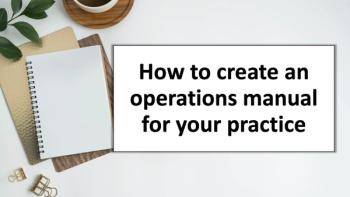
Efficiency: Conquering Time
Do you feel overwhelmed every day? From the nation’s leading time-management experts, here’s the best advice on how to make the most of your day.
If your practice is like so many we hear about, you’re struggling to become more efficient without turning yourself and your staff into robots.
On one hand, you need to save money: Resources are dwindling. Cash flow is topsy-turvy. It seems the only way to survive is to get through each day, each patient visit, each claim, as economically as possible.
But who wants to live life that way? It’s depressing and unrealistic to be rigorous every second. In reality, patients are chatters, medicine is messy, billing is Byzantine, and steely, production-line practice is both icky and impossible. No physician chose medicine in order to process patients like parts in an auto plant. What to do? Compromise: There are ways to get more done without bringing a stop watch to every patient encounter. Here are our five best ideas.
1. Study the process
Start by being the scientist that you are and simply study some of the processes in your practice that seem to bog things down.
Have you ever seen the 1950s movie “Cheaper by the Dozen?” Frank and Lillian Gilbreth, featured in the film and book, took this concept to its extreme in the high rosy days of the late industrial revolution. Frank, for example, studied bricklayers. Watching carefully, he managed to reduce the number of motions required to lay a brick from 18 to about five.
You can apply the same approach to scheduling, billing, or managing refill requests. It’s fine to be a little less obsessive about it than the Gilbreths. Just taking some time to step back and bring awareness to the problem can go a long way.
“People just run in [to work] and start running around,” Judy Capko, author of “Take Back Time: Bringing Time Management to Medicine,” points out. “People need to reflect a little on what went right or wrong in the day so they can avoid the same crises reoccurring. You won’t identify it unless you reflect.”
Capko recalls working with a frustrated dermatologist. The poor fellow wanted to sail smoothly from exam room to exam room, but every time he left one patient, he had to stand around, looking for a nurse to tell him which exam room to go into next. It was the same story every day; all the yelling in the world wasn’t fixing it.
So, Capko got the nursing staff and the physician in a room and together they walked through the processes in their practice. They even role played, with some staff playing patients. They got everyone’s perspective on what was going wrong and came up with two easy fixes.
“He’d been living with this problem for …years,” says Capko, “and the solution was a slam dunk.”
First, the team realized nurses could never be omnipresent, so they agreed to start using a room-manager function they discovered in their EMR. By putting a portable computer in the nurses’ station, the dermatologist can now see where he needs to be by pressing a button.
The practice also invested in larger monitors in the exam rooms. One reason nurses were hard to find was because they were forced to retreat to a back room to complete charting. The monitors in the exam rooms could only display eight-point type, too tiny to read easily.
Watch, too, for wasteful process you hardly even notice anymore.
“It’s just like you don’t realize your wallpaper is getting old because you live with it. You live with something so long, you don’t realize it’s not working,” Capko offers. How many steps are in your scheduling process? What, exactly, happens to a denied claim? Consider actually writing down each step and thinking about what you can eliminate.
Donald Wetmore, a time-management guru who founded the Productivity Institute in Stafford, Conn., figures it’s worth the time it takes to work through it.
“Even if it takes you an hour to figure out how to save 10 minutes a day, you reap long-term benefits. Huge increases in productivity do not require huge efforts. Physicians are already incredibly productive; it’s a matter of small changes.”
2. Hand it over
Here’s another way to be more efficient without sacrifice: Stop doing all the work yourself. Delegation is key to managing your time.
Wetmore used to be a managing partner at a law firm. He was spending all day answering questions and managing problems for staff and colleagues. He got out of the muddle with two techniques.
First, he simply asked people to hold their questions until after 4 p.m. Folks were often able to solve the issue before the end of the day without him.
Second, he used “reverse delegation.” Say a manager had a “monkey on her back” trying to work around a conflict in scheduling seminars.
Wetmore’s impulse was to say, “I’ll take care of it.” But “after a day or two [of taking all the monkeys] you become a zoo keeper. If you allow people to come and dump on you, they will dump on you. People want to go the line of least resistance. Instead ask, ‘So what do you think? I have confidence in you.’ Most people that practice that reverse delegation thing find they can eliminate a lot of those things they’d otherwise get caught up in.” Wetmore calls this “reverse delegation” because staff are expected to find their own solutions, not just perform pre-set tasks.
Asking your staff to solve problems doesn’t just reduce the load on you; it also builds their confidence and means they will be more likely to affect positive changes in the practice.
More literal delegation is another option. Ask your staff to do more. “I don’t think we use our nursing staff to the max. And busy as they are, I think nurses tend to be more efficient if they are busier,” Capko offers.
It may also be that you need more help. Many practices are proud of how they get by with fewer-than-average employees, figuring that this is a sign of cost-effectiveness, but often the reverse is true: Understaffed practices tend to be less efficient, especially when physicians are spending their valuable time on tasks that could be performed by lower-paid staff, if only there were enough staff to do the job. “If by adding staff, it frees up the physician’s time to see X number of additional patients a day, it’s not an expense - it’s an investment,” Wetmore says.
Of course your office has patients in it, as well as staff. Smart practices set high expectations for patient involvement. You might have patients make their own appointments online, type their own medical histories into software that interacts with your EMR, or keep a personal health record.
We’ve even heard stories from practices that encourage patients to pay their portion of the bill once they get an EOB from their payer. They know what they owe; why wait for a bill from the doctor?
Educating patients about how to best handle refill requests is another way you can push work onto patients. In group visits, patients can educate one another about their common disease. Some practices are even using electronic kiosks at check-in. Similar to check-in machines at hotels and airports, the machines recognize patients, check their insurance, and even process copays. It may sound impersonal, but, in fact, it’s possible to improve patient satisfaction with the digital interfaces. They reduce lines, can offer information in multiple languages, and patients can easily see their own demographic data, enabling billing to work easily for you and them. And consumers have gotten quite used to self-service technology: It’s how they do most of their banking, buy gasoline, and even purchase groceries.
Simply asking patients to write down their main concerns and prescription needs before they enter the exam room can be a big time saver, too. “Let’s face it, you only have 10 minutes,” Capko points out. “How do you make that time the best it can be?”
3. Get focused
Keeping focused is the third way to improve efficiency. Whatever you are doing, it’s best to keep the goal in mind and minimize distractions.
First, think broadly: What are your goals for the practice this year? What will make that happen?
Then narrow it down: What tasks are most important to get done in any one day? Create the complete list, and then focus on what really needs to get done instead of hopping from task to task.
For example, it may not be possible to cover everything in a single exam. So start by eliciting all the patient’s concerns at the beginning of the session. That means not cutting off the conversation at the first concern the patient mentions. Physicians “tend not to ask if patients have more questions for fear it will take more time, but in reality, it takes less, because the questions a patient has don’t go away. They turn into phone calls which take more time … not only for the doctor but his or her staff. And those calls don’t come in at your convenience,” Capko says.
Once you know what you are facing, you can suggest spending most of the visit on one or two core issues and touch on other topics more briefly. You can plan the visit instead of working willy-nilly.
The enemy of focus is interruption. Every phone call, nurse question, and pharma-rep visit forces you to multitask and takes you off your game plan. So what to do?
Setting expectations can help. “A lot of the frustration comes from not establishing the rules up front,” Wetmore says. “People will play by the rules if you tell them what they are.”
For example, when patients call in with a question that needs your attention, staff can tell them that you’ll call back by 4 p.m., or whatever time is realistic. That spares you a second phone call when the patient calls 30 minutes after her initial call, wondering why she hasn’t heard from you, and it allows you to plan your day.
Watch out, too, for the ways you interrupt yourself inadvertently. Set aside specific times to review e-mail or reply to phone messages instead of checking constantly. If you need to manage some personal or business issue during office hours, set a time to get it done instead of thinking about it throughout the day.
Try to reduce the temptation to overdo the multitasking - another form of interrupting yourself. Consider this scenario: You are a pediatrician running behind schedule. While waiting on a quick strep result for the patient in Exam Room One, you jump into Exam Room Two. It feels like you are using your time well. But the case in Room Two is complicated, there is a lot to explain, and 15 minutes later, you have to interrupt yourself to go back to where the exasperated strep-patient’s parent has been waiting, write a script, then be waylaid by a frantic nurse on your way back to Exam Room Two, where you end up repeating yourself to get the conversation back on track. It might be less stressful and more efficient to do one thing at a time. Sure, maybe you can take on some quick task while waiting for the lab result, but diving into a whole new project can make for more confusion instead of less.
Better yet, plan the day to avoid the temptation to multitask. If you are seeing a lot of strep, consider instructing your nurse to do a strep test on every child presenting with a sore throat on intake. That way, the results are ready when you enter the exam room. There is no need to interrupt the exam to order the test or wait for results.
If you are not able to easily identify such time-savers or put your finger on why you feel constantly interrupted, try keeping an interruptions log. “A problem well-defined is 95 percent solved,” Wetmore notes.
Simply grab a pad of paper and, with each interruption, note who interrupted you, why, and how much time it took. Then rate on a scale from A to D how important each interruption was, giving an A to the most significant.
Keep it up for a week or so. Then focus on reducing the C- and D-level interruptions, the not- very-important ones, especially if they are repetitive.
4. To thine own self be true
Most of us are more productive at some times of the day than others. Accept it, and use it.
If you don’t really get going until 10 a.m., why not start your office hours at 10 and work through to 6 p.m.? You can always come into the office early and spend that sleepy time catching up on paperwork.
Morning person? Go ahead and see patients at 7 instead of wasting your go-get-em hours on e-mail.
Similarly, know what your strengths are. Industry experts may opine about the inefficiency of batching work, urging physicians to do charting after every couple of visits instead of at the end of the day. You might hear about others saving time by sending lab results via e-mail or having clinical support staff handle more patient care. You might even know colleagues with digital day timers that beep with reminders to stay on time or complete one task or another. But if these methods sound unbearably foreign to you, realize that you don’t have to adopt them. Be yourself. It’s better to find a time-management technique you will actually use than to never use the time-management techniques someone else likes.
5. Just relax
For that matter, it’s worth considering how much more efficient you really want to be. Jennifer Alexander, assistant professor of mechanical engineering at the University of Minnesota, points out that American culture is obsessed with efficiency - that more is always considered better. Her book, “The Mantra of Efficiency,” examines how this near-religious principle took hold in the late industrial revolution.
Now it’s considered an end in itself.
You’re not a robot; don’t try to turn yourself into one. “I decide to resist my own impulses and even the productiveness criteria that’s all around us,” Alexander says. “So I write fewer articles each year than others and people give me grief about it. It’s not an easy choice.”
Accepting any level of inefficiency is certainly not easy for physicians whose business depends heavily on volume. But how many patients does your practice really need to see to make ends meet? Maybe it’s time to do the calculations.
Certainly, too many feel so pressed to work hard, they never take the opportunity to step back and look at how they can work smarter. The drive for efficiency itself gets in the way of efficiency.
Taking some time to review your workflow can mean more time, and less anxiety about production, later on.
Pamela Moore is senior editor, practice management, for Physicians Practice. She can be reached via
This article originally appeared in the February 2008 issue of Physicians Practice.
Newsletter
Optimize your practice with the Physicians Practice newsletter, offering management pearls, leadership tips, and business strategies tailored for practice administrators and physicians of any specialty.














